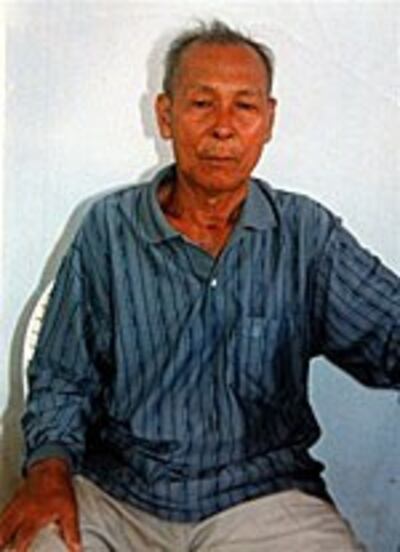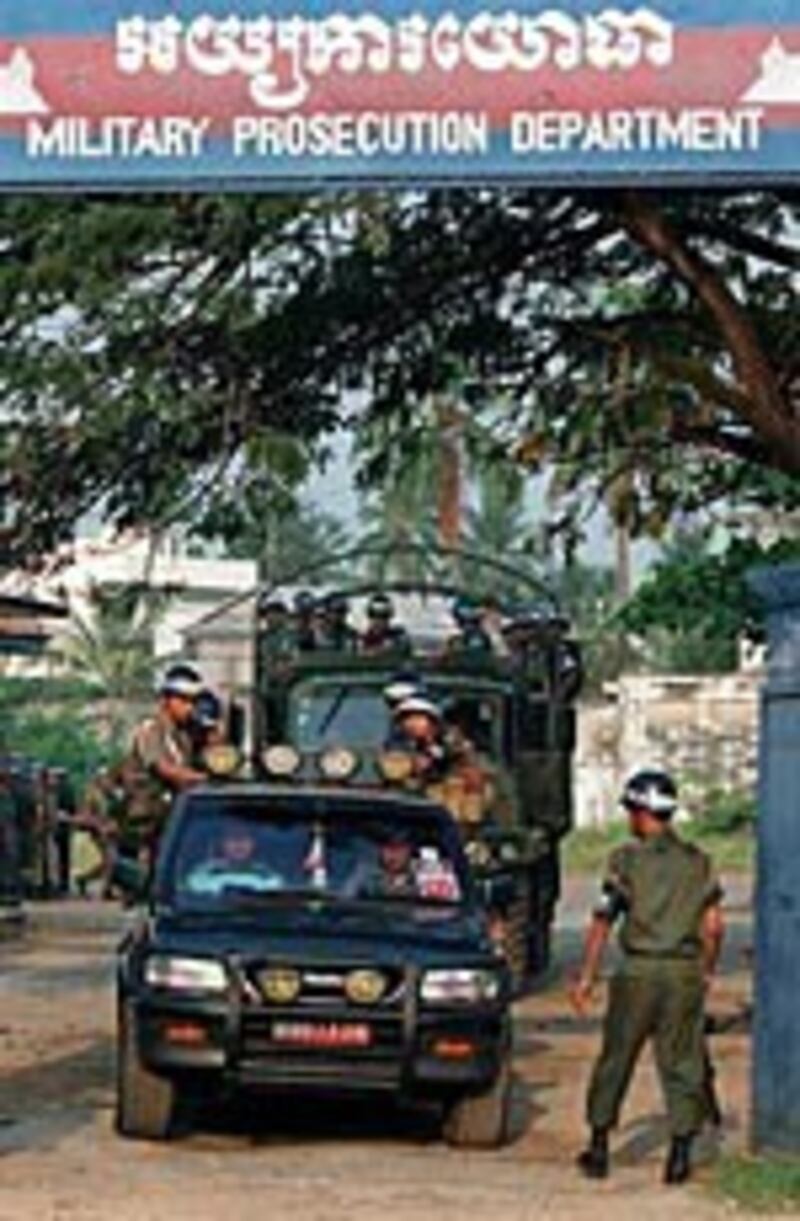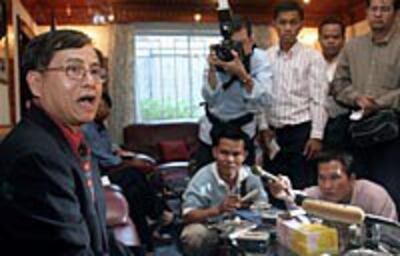
PHNOM PENH—Ta Mok, the 82-year-old former Khmer Rouge commander whose actions earned him the nickname “The Butcher,” has died at a military hospital in the Cambodian capital.
Ta Mok, who died Friday, was being treated for high blood pressure, tuberculosis, and breathing complications, his lawyer, Benson Samay, said.
Widely known as a ruthless enforcer for Khmer Rouge leader Pol Pot, Ta Mok remained powerful for years after Vietnam toppled the Khmer Rouge. He controlled northern areas of the Khmer Rouge's remaining territory from his base at Anlong Veng.
One of two defendants in custody
After a split in the party, he declared himself supreme commander in 1997 and was detaining Pol Pot when he died.
Earlier this month, officials were sworn in for a long-awaited trial of those blamed for the deaths of an estimated 1.7 million people under the Khmer Rouge from 1975-79. Ta Mok could have provided key testimony against other defendants.
Only Ta Mok and former prison commander Kaing Khek Iev, also known as Duch, were in custody ahead of the trial, and many people fear that more defendants—all of whom are elderly—may die before they can be tried.

On July 13, his lawyer summoned the media to report that Ta Mok had lapsed into a coma.
His illness did “not coincide with the operations of the Khmer Rouge tribunal,” he said, adding that his client suffered “a long, chronic, old-age disease, because he was already 82 years old.”
Candidate for prosecution
He also blamed “the carelessness of those responsible who let Ta Mok become so severely ill,” local media reported. Ta Mok was a top commander of the army of Democratic Kampuchea, generally known as the Khmer Rouge regime.
He was arrested March 6, 1999 in Anlong Veng district in the northwestern part of Cambodia and detained at the Military Prison in Phnom Penh awaiting trial by a unique tribunal.
The tribunal, formally called Extraordinary Chambers in the Courts of Cambodia, is described as a "hybrid court" operating according to Cambodian laws but staffed by judges, prosecutors, and others from a number of countries in addition to Cambodians.
Ta Mok is one of the Khmer Rouge leaders profiled in Seven Candidates for Prosecution by Steve Heder, which lays out the cases against seven top leaders.
Heder cites "significant evidence that Ta Mok…played a central role in implementing the Communist Party’s execution policies.”
Khmer Rouge family links
According to research documents published by the Documentation Center of Cambodia (DC-CAM), Ta Mok was born with the original name of Ung Choeun.

Ta Mok has also been known by other names: Ta 15, Chhit Choeun, Ek Choeun, A’cha Choeun, and Nguon Kang.
Ta Mok was born in 1926, the Year of the Tiger in the local horoscope, in Prokeab village, Southern Trapaing Thom commune, Tramkak district, Takeo province, which was also known as Region 33 in the Southwest Region.
Ta Mok was married to his cousin Ouk Khim. He was the eldest in a family of seven children.
He is survived by a brother, Ouk Chok, or Chong, who was a district governor and Party secretary for Prey Kabas district in Takeo province.
Ta Mok: A brief chronology
He is also survived by a sister, Ung Poun, 64, who was married to another district governor, and still lives in Takeo province, and three younger sisters.
Ta Mok was raised by his grandmother and spent the first 18 years of his life attending schools in his home district, Trapaing Thom.
1949. Ta Mok became the leader of a resistance group called "Issarak" for Takeo province's Tramkak district. He joined the Kampuchean Communist Party in 1963, serving as a member of the Party's central committee.
1968-69. Ta Mok was appointed Party secretary for the Southwest Region during which he and his comrade Hu Nim had a political row.
Early 1970s. Ta Mok was Party secretary for the Southwest Region.
June 1971. Attended a two-day congress of the Kampuchean Communist Party, which was held at Pol Pot's office in the Northern Region.
1972. Held a meeting in Kampong Chhnang province in which he called on some 3,000 monks in attendance to join the army.
1972-73. Became leader of the Khmer Rouge movement in the region.
1973. Put in command of the army in the Southwest Region. Started to kill "betrayers" in Kampong Speu province and Hanoi-backed comrades in the Southwest Region.
1974. Together with another Khmer Rouge Commander Ke Pok, attacked and occupied Udong district and Kampong Chhnang province.
September 1975. Ta Mok sat on the Party's Standing Committee.
March 30, 1976. Appointed by the Party's Central Committee as Second Vice Chairman of the Standing Committee of the Democratic Kampuchean parliament.
1977. Commander-in-chief of the army.
1978. Appointed secretary-general of the Kampuchean Communist Party for the Southwest Region. At this time Ta Mok's group was accused of being responsible for the killing of 30,000 people in Angkor Chey district, Kampot province.
November 1978. Appointed vice secretary general of the Kampuchean Communist Party.
1979. Commander of a military division in Kampong Tralach district, Kampong Chhnang province. Continued to hold an important position in the Khmer Rouge until he was arrested
March 6, 1999. Arrested in Anlong Veng district in the northwestern part of Cambodia and detained at the Military Prison in Phnom Penh awaiting trial.
When he was 19, Ta Mok studied in a Buddhist pagoda-based school and became a monk in Wat Mohamontrey pagoda until graduation. Once past 30, Ta Mok abandoned his monkhood and married a woman from the same village.
Ta Mok fled into the jungle in the territory of Kampot Province to join a resistance movement. Later, his wife went to live in the Leach district of Pursat province.
Original reporting in Khmer by Maly Leng. Translated by Sothea Thai. RFA Khmer service director: Kem Sos. Edited by Sarah Jackson-Han and Luisetta Mudie.
